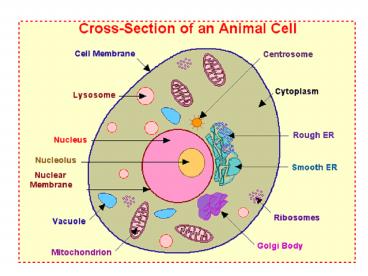Mitochondria - PowerPoint PPT Presentation
Title:
Mitochondria
Description:
Parenchyma cells- most abundant cells in plants; spherical cells which flatten at point of contact; alive at maturity; pliable, primary cell walls; large vacuoles for ... – PowerPoint PPT presentation
Number of Views:497
Avg rating:3.0/5.0
Title: Mitochondria
1
(No Transcript)
2
(No Transcript)
3
(No Transcript)
4
(No Transcript)
5
Mitochondria Mitochondria are membrane-enclosed
organelles distributed through the cytosol of
most eukaryotic cells. Their main function is the
conversion of the potential energy of food
molecules into ATP. Every type of cell has a
different amount of mitochondria.. There are more
mitochondria in cells that have to perform lots
of work, for example- your leg muscle cells,
heart muscle cells etc. Other cells need less
energy to do their work and have less
mitochondria.
6
- Mitochondria have
- an outer membrane that encloses the entire
structure - an inner membrane that encloses a fluid-filled
matrix - between the two is the intermembrane space
- the inner membrane is elaborately folded with
shelflike cristae projecting into the matrix.
7
Endoplasmic reticulum (ER)- It is a network of
membranes throughout the cytoplasm of the cell.
There are two types of ER. When ribosomes are
attached it is called rough ER and smooth ER when
there are no ribosomes attached. The rough
endoplasmic reticulum is where most protein
synthesis occurs in the cell. The function of the
smooth endoplasmic reticulum is to synthesize
lipids in the cell. The smooth ER is also helps
in the detoxification of harmful substances in
the cell.
8
(No Transcript)
9
(No Transcript)
10
The fluid mosaic model describes the structure
of the plasma membrane.Different kinds of cell
membrane models have been proposed, and one of
the most useful is the Fluid-mosaic model. In
this model the membrane is seen as a bilayer of
phospholipids in which protein molecules are
embedded.
An illustration of the Fluid mosaic model
11
(No Transcript)
12
(No Transcript)
13
Lysosomes function as the cell's recycling
compartment. Lysosomes receive cellular and
endocytosed proteins and lipids that need
digesting. The metabolites that result are
transported either by vesicles or directly across
the membrane.
14
- Steps in lysomal
formation - The ER and Golgi apparatus make a lysosome
- (2) The lysosome fuses with a digestive
vacuole(3) Activated acid - hydrolases digest the contents
15
(No Transcript)
16
The centrosome, also called the "microtubule
organizing center", is an area in the cell where
microtubles are produced. Within an animal cell
centrosome there is a pair of small organelles,
the centrioles, each made up of a ring of nine
groups of microtubules. There are three fused
microtubules in each group. The two centrioles
are arranged such that one is perpendicular to
the other. During animal cell division, the
centrosome divides and the centrioles replicate
(make new copies). The result is two centrosomes,
each with its own pair of centrioles. The two
centrosomes move to opposite ends of the nucleus,
and from each centrosome, microtubules grow into
a "spindle" which is responsible for separating
replicated chromosomes into the two daughter
cells.
17
- cilia are thread-like projections of certain
cells that beat in a regular fashion to create
currents that sweep materials along
18
Flagella may extend to the rear of a cell and
push it forward by snakelike wriggling, or stick
out in front and draw it along.
We humans possess both flagella and cilia. Each
sperm cell is propelled by a trailing flagellum
that accelerates the little torpedo forward in
its quest to fertilize an egg.
19
(No Transcript)
20
(No Transcript)
21
(No Transcript)
22
(No Transcript)
23
One of the most important distinguishing
features of plant cells is the presence of a cell
wall, a which serves a variety of functions.
The cell wall protects the cellular contents
gives rigidity to the plant structure provides a
porous medium for the circulation and
distribution of water, minerals, and other small
nutrient molecules and contains specialized
molecules that regulate growth and protect the
plant from disease. A structure of great tensile
strength, the cell wall is formed from fibrils of
cellulose molecules, embedded in a
water-saturated matrix of polysaccharides and
structural glycoproteins. .
24
(No Transcript)
25
Vacuoles and vesicles are storage
organelles in cells. Vacuoles are larger than
vesicles. Either structure may store water, waste
products, food, and other cellular materials. In
plant cells, the vacuole may take up most of the
cell's volume.
The membrane surrounding the plant cell vacuole
is called the tonoplast.
26
(No Transcript)
27
(No Transcript)
28
(No Transcript)
29
Epithelial Tissue Epithelial tissues come in
three basic types squamous, cuboidal and
columnar. These three types of tissue are seen in
either simple (only one cell layer thick) or
stratified (many cells in thickness) arrangements.
The Simple Epithelial Tissue Types
30
(No Transcript)
31
The Stratified Epithelial Tissue Type
It is called pseudostratified due to the
differing heights of the cells and the nuclei
within the cells, making the epithelium look as
if it is multilayered (stratified). The prefix,
"pseudo" means "fake" or "not real", so
pseudostratified literally means, "not really
multilayered."
32
Palisade mesophyll is a tissue made up of many
similar cells
33
(No Transcript)
34
(No Transcript)
35
(No Transcript)
36
This powerpoint was kindly donated to
www.worldofteaching.com http//www.worldofteac
hing.com is home to over a thousand powerpoints
submitted by teachers. This is a completely free
site and requires no registration. Please visit
and I hope it will help in your teaching.































